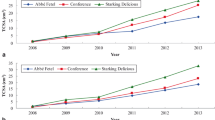Abstract
The aim of the study is to determine the effect of different growth vigorous rootstocks on phenolic compounds in leaves of apple. For this purpose it was used the leaves of cultivar ‘Red Chief’ grafted on dwarf (M9), semi-dwarf (M26) and semi-vigorous (MM106) rootstocks. During mid-July, the leaf samples were taken from the middle part of annual shoots. Phenolics of the leaves were determined by HPLC analysis. While significant differences among the rootstocks for p-hydroxybenzoic acid, eriodictyol, ferulic acid and p-coumaric acid were detected, these differences were insignificant for gallic acid and quercetin. It was shown that semi-vigorous rootstocks (MM106) had higher phenolic contents in total than the other two dwarf rootstocks. In addition, apigenin-7-glucoside, chlorogenic acid, caffeic acid, rosmarinic acid, epicatechin, syringic acid, catechin, rutin, resveratrol, hesperidin, naringenin, luteolin, apigenin and acacetin could not to be detected. Data showed that there is the relationship between growth vigour and phenolic contents of apple leaves. Especially, p-hydroxy benzoic acid and p-coumaric acid contents were higher in semi-vigorous rootstock than in dwarf rootstock.
Zusammenfassung
Das Ziel dieser Studie ist es, den Effekt von verschiedenen Wuchsstärken bei Unterlagen auf phenolische Verbindungen in Apfelblättern der Edelsorte zu untersuchen. Zu diesem Zweck wurden Blätter der Sorte ‘Red Chief’ verwendet, die auf schwachwachsende (M 9), halb-schwachwachsende (M 26) und mittelstarkwachsende (MM 106) Unterlagen veredelt war. Die Blattproben wurden Mitte Juli aus dem mittleren Teil der diesjährigen Triebe entnommen. Die in den Blättern enthaltenen Phenole wurden mittels HPLC-Analyse bestimmt. Während zwischen den Unterlagen signifikante Unterschiede bei p-Hydroxybenzoesäure, Eriodictyol, Ferulasäure und p-Cumarsäure gefunden wurden, waren die Unterschiede bei Gallussäure und Quercetin nicht signifikant. Es kann festgestellt werden, dass bei mittelstarkwachsenden Unterlagen (MM 106) ein höherer Gesamt-Phenolgehalt enthalten ist als bei den beiden schwachwachsenden Unterlagen. Es ist zu ergänzen, dass Apigenin-7-Glycoside, Chlorogensäure, Kaffeesäure, Rosmarinsäure, Epicatechin, Syringasäure, Catechin, Rutin, Resveratrol, Hesperidin, Naringenin, Luteolin, Apigenin und Acacetin nicht festgestellt wurden. Die Auswertungen zeigen, dass eine Beziehung zwischen der Wuchsstärke und dem Phenolgehalt in Blättern besteht. Besonders die Gehalte an p-Hydroxybenzoesäure und p-Cumarsäure waren bei mittelstarkwachsenden Unterlagen höher als bei schwachwachsenden.

Similar content being viewed by others
References
Baritt BH (1992) Intensive orchard management. Fruit grower a division of Washington State Fruit Commission 1005 Tieton Drive, Yakima, Washington
Baurhoo B, Ruiz-Feria CA, Zhao X (2008) Purified lignin: nutritional and health impacts on farm animals. Anim Feed Sci Technol 144:175–184
Cao MG, Yang HL, Zhang W, Zhang ZD, Su YW, Zhu YD (2008) Parameters for evaluating dwarfing ability in apple rootstocks. J China Agric Univ 13:11–18
Caponio F, Alloggio V, Gomes T (1999) Phenolic compounds of virgin olive oil: influence of paste preparation techniques. Food Chem 64:203–209
Dzieciol U, Antoszewski R (1984) Mechanisms of action of dwarfing interstem in apple trees. I. Distribution of the 14C-assimilates in double-worked trees with dwarfing and vigorous interstems and metabolism of labelled assimilates within the interstem. J Fruit Sci Rep 11:55–66
Fallahi E, Colt W, Fallahi MB, Chun IKJ (2002) The importance of apple rootstock on tree growth, yield, fruit quality, leaf nutrition, photosynthesis with an emphasis on ‘Fuji’. Horttechnology 12:38–44
Garcia E, Rom CR, Murphy JB (2004) Comparison of phenolic content of ‘Liberty’ apple (Malus × domestica) on various rootstocks. Acta Hortic 658:57–60
Gonçalves B, Moutinho-Pereira J, Santos A, Silva AP, Bacelar E, Correia C, Rosa E (2005) Scion-rootstock interaction affects the physiology and fruit quality of sweet cherry. Tree Physiol 26:93–104
Gosch C, Halbwirth H, Kuhn J, Miosic S, Stich K (2009) Biosynthesis of phloridzin in apple (Malus domestica Borkh.). Plant Sci 176:223–231
Jindal KK, Dalbro S, Andersen AS, Poll L (1974) Endogenous growth substances in normal and dwarf mutants of Cortland and Golden Delicious apple shoots. Physiol Plant 32:71–77
Kroon PA, Williams G (1999) Hydroxycinnamates in plants and food: current and future perspectives. J Sci Food Agric 79:355–361
Li LH, Zhang H, Yu C, Ma L, Wang Y, Zhang XZ, Han ZH (2012) Possible roles of auxin and zeatin for initiating the dwarfing effect of M9 used as apple rootstock or interstock. Acta Physiol Plant 34:235–244
Lockard RG, Schneider GW, Kemp TR (1982) Phenolic compounds in two size-controlling apple rootstocks. J Am Soc Hortic Sci 107:183–186
Mainla L, Moor U, Karp K, Pussa T (2011) The effect of genotype and rootstock on polyphenol composition of selected apple cultivars in Estonia. Žemdirbystė = Agriculture 98:63–70
Miller SR (1965) Growth inhibition produced by leaf extracts from size controlling apple rootstocks. Can J Plant Sci 45:519–524
Nachit M, Feucht W (1976) Suitability of phenolic and amino acids as selection criteria for the vigour of Malus rootstocks. Mitt Rebe Wein, Obstbau Fruchteverwertung 26:199–204
Nadernejad N, Ahmadimoghadam A, Hossyinifard J, Poorseyedi S (2013) Effect of different rootstocks on pal activity and phenolic compounds in flowers, leaves, hulls and kernels of three pistachio (Pistacia vera L.) cultivars. Trees 27:1681–1689
Palfitov VF (2003) Methods for determination of growth vigour of apple rootstocks. Sadovod Vinograd 3:12–13
Usenik V, Stampar F (2002) Influence of scion/rootstock interaction on seasonal changes of phenols. Phyton 42:279–289
Usenik V, Stampar F, Fajt N (2005) Seasonal changes in polyphenols of ‘Lapins’ sweet cherry grafted on different rootstocks. Acta Hortic 667:239–246
Wertheim SJ (1998) Rootstock Guide. Apple, pear, cherry, european plum. Fruit, Research Station, Brugstraat 51, 4475 AN Wilhelminadorp
Yıldırım AN, Koyuncu F (2005) A study on the production of nursery tree in Isparta province. Derim 22:20–28
Author information
Authors and Affiliations
Corresponding author
Rights and permissions
About this article
Cite this article
Yıldırım, F., Yıldırım, A., San, B. et al. The Relationship Between Growth Vigour of Rootstock and Phenolic Contents in Apple (Malus × domestica). Erwerbs-Obstbau 58, 25–29 (2016). https://doi.org/10.1007/s10341-015-0253-7
Received:
Accepted:
Published:
Issue Date:
DOI: https://doi.org/10.1007/s10341-015-0253-7




